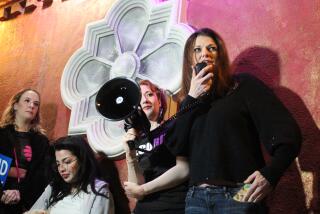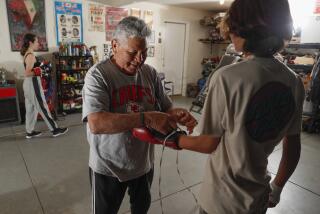Boxing at the Garden Is Undergoing a Revival
- Share via
NEW YORK — Boxing is being revived at Madison Square Garden.
Ah, the Garden.
Muhammad Ali-Joe Frazier I. Sandy Saddler-Willie Pep. Joe Louis-Jersey Joe Walcott. Champions like Sugar Ray Robinson, Ike Williams, Kid Gavilan and Emile Griffith strutting their stuff. Friday night heroes like Ernie (The Rock) Durando, Tuzo (Kid) Portugese, Pete Mead and Joey DeJohn bringing crowds to their feet.
It was the Mecca of boxing. It is not likely to be again--a victim of a changing world where casino-hotels like Caesars Palace and the Las Vegas Hilton bid big bucks for big-money fights.
But Bob Gutkowski, a Garden boxing executive, thinks the arena can once again be a showcase for the sport.
Network television will not black out the New York metropolitan area, a policy that ruins the live gate. But commercial television really isn’t a factor in major fights anymore, in this era of cable and pay-per-view TV.
Gutkowski, president of the Garden’s cable network, says: “We can do pay-per-view and closed-circuit television fights in the main arena.”
And, he said, “If ever there is a Gerry Cooney-Mike Tyson fight, we can do it as well as Las Vegas.” Cooney is from Long Island and Tyson, the World Boxing Council heavyweight champion, came off the mean streets of Brooklyn.
Meanwhile, the primary goal is to change the Garden’s image from that of the seedy fight club it had become. With hardly ever a fight in the main arena, the boxing menu was one of numerous mismatches or dull matches in the Felt Forum, before hard-core crowds of 700 or 800 people. The fights among the paying customers often were better than the ones in the ring.
But the 4,500-seat Felt Forum is vibrant again. Average attendance for bi-weekly shows there in 1985 was 737. In 1986, it was about 1,800. Women are attending in larger numbers; coats and ties are on view, especially since fight night has been changed from Friday to Thursday when people are less likely to be socially engaged or feel the need to rush home.
“We get 100 phone calls some days looking for fights (on the bi-weekly Forum shows),” said Steve Griffith, brought in from NBC to market boxing for the Garden.
“I got a call from a guy who heard good things and wanted his boy to fight in New York,” said Gutkowski, who was brought to the Garden by Alan R. Fields when Fields became the Garden’s executive vice president and chief operating officer for Madison Square Garden Corp.
“Alan Fields has a tremendous love for the building and respect for the relationship between the building and boxing,” Gutkowski said.
Also well aware of the historic relationship between the Garden and boxing is the man Gutkowski hired as boxing director--Bobby Goodman, whose father, Murray, was the Garden’s boxing publicist from 1949-1960.
“More and more we’re getting stronger; we’re developing fighters,” said Goodman, who worked 12 years for promoter Don King. He has been at his post for a year and is a prime reason for the enthusiasm that grips the boxing department.
Olympic champions Mark Breland, Tyrell Biggs, Pernell Whitaker, Meldrick Taylor and Virgil Hill fought in the Forum last year. So did middleweight contenders Michael Olijade and Iran Barkely and former world featherweight champion Juan LaPorte.
Four world title bouts were featured in the 20,000-seat main arena, where not long ago the reason for a live card was to provide preliminary bouts to a closed-circuit telecast of a fight originating elsewhere.
“We were co-promoters in all of those shows,” Goodman said, “but we are talking about some of our own shows there this year.”
One of the 1986 main arena cards featured James “Bonecrusher” Smith’s one-round knockout of Tim Witherspoon for the World Boxing Association heavyweight title. Another was Hector (Macho) Camacho’s split decision win over Edwin Rosario in defense of the World Boxing Council lightweight title.
And boxing’s hottest property, heavyweight Tyson, made two pre-title- winning appearances in the big building.
The biggest attendance in the main building was a disappointing 10,000 for the Camacho-Rosario card. But Gutkowski saw the shows in the main Garden as a positive step.
“The negatives in New York are no longer,” Goodman said.
The biggest negative took effect in July 1957, when U.S. District Judge Sylvester J. Ryan ruled that James J. Norris, Arthur Wirtz, Madison Square Garden and various international boxing clubs violated the Sherman Antitrust Act by restraining trade and monopolizing the promotion of world title fights in the United States.
In January 1959, the U.S. Supreme Court upheld Ryan’s decision, and the Garden could not sign fighters to multiple-fight promotional contracts.
On May 5, 1978, the decree was modified to allow the arena to sign promotional contracts of up to four bouts. Then on June 30, 1981, the four-bout limit was lifted, putting the Garden on equal footing with other promoters.
A New York State tax on fighters’ purses was also dropped.
Gone, too, is the negative attitude concerning boxing.
“There is no second guessing,” Gutkowski said when asked about executive hindsight about the boxing program. “Everybody is very understanding about the long road we have to travel.”
More to Read
Go beyond the scoreboard
Get the latest on L.A.'s teams in the daily Sports Report newsletter.
You may occasionally receive promotional content from the Los Angeles Times.










